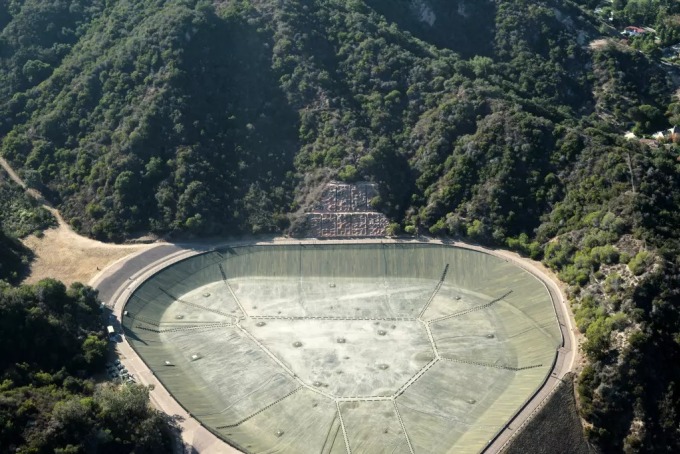
The Santa Ynez Reservoir in Los Angeles has come under scrutiny after being found dry during the city’s wildfire emergency, complicating efforts to combat the disaster.
Wildfires broke out on January 7 in areas such as Pacific Palisades, Eaton, and Hurst within Los Angeles, California. Nearly ten days later, the fires continue to rage, destroying or damaging over 12,000 homes and structures and forcing the evacuation of more than 100,000 residents.
The crisis has raised questions about Los Angeles officials' preparedness for wildfires. The Santa Ynez Reservoir, located in Pacific Palisades, was dry when the fires began, reportedly hampering firefighting efforts. Low water pressure at numerous hydrants made them unusable, frustrating firefighters on the ground.
The Santa Ynez Reservoir, managed by the Los Angeles Department of Water and Power (LADWP), has a capacity of 443,000 cubic meters and is supplied by water from the larger Stone Canyon Reservoir through a 75-centimeter diameter pipeline. According to reports, Santa Ynez was drained in February 2024 for repairs to its surface cover, initially installed in 2011 to meet federal water quality standards.
The cover, designed to last 20 years, was found to have tears that could allow debris, bird droppings, and other contaminants into the water. LADWP drained the reservoir in February 2024, began soliciting bids for repairs in April, and awarded the contract to Layfield, a company based in Lakeside, in November. The progress of the repairs remains unclear, and records show the cover underwent repairs previously in 2022, also managed by Layfield.
“A reservoir left empty for nearly a year for minor repairs is completely unacceptable,” said Gus Corona, a union leader at LADWP. “This work should have been done in-house instead of relying on outside contractors. This was avoidable.”
Joseph Ramallo, LADWP’s director of communications, stated that Santa Ynez was scheduled to be operational again by February 2025, but it is uncertain whether the reservoir could have been refilled in time to aid firefighting efforts.
The Stone Canyon and Santa Ynez reservoirs also supply water to local storage tanks, each holding approximately 3,800 cubic meters, which service higher-elevation areas in Pacific Palisades. Officials confirmed these tanks were full before the fires but quickly depleted as firefighters drew water from hydrants while demand surged in other areas.
LADWP officials admitted that having Santa Ynez operational could have improved water pressure during the fires. Los Angeles Fire Department (LAFD) Chief Kristin Crowley said she was unaware of Santa Ynez's status, adding that several hydrants in Pacific Palisades ran dry on January 7 when flames swept into the area, destroying over 5,000 structures.
Former LADWP General Manager Martin Adams argued that refilling the reservoir when fire risk is identified could be feasible but "pointless" without knowing where the fire would start.
"Preemptively filling reservoirs could result in non-potable water and potential waste," Adams said. "You’d need to issue boil water notices or dump the water into the ocean later. Santa Ynez is no silver bullet for an overloaded system."
Dr. David Freyberg, a water resource expert at Stanford University, acknowledged that a full Santa Ynez Reservoir could have offered some benefits but doubted it would significantly impact such a large-scale fire. "These reservoirs are designed for residential fire suppression, not wildfires of this magnitude," he said.
Tom Kennedy, a water resource consultant, agreed. He argued that even with Santa Ynez supplying additional water, the destruction caused by the fires would not have been significantly reduced due to the scale of the blaze and limitations in the water system.
"The pipelines are too small to make a real difference against a fire of this size," Kennedy said. "Wildfires with strong winds will consume everything in their path until weather conditions change."
"Communities at risk of wildfires need to rethink system design, including reservoir capacity, pipeline size, and water pressure management," Freyberg added.
California Governor Gavin Newsom called for an independent investigation on January 10 into the empty Santa Ynez Reservoir and reduced water pressure in affected areas. He requested LADWP prepare a "comprehensive report" on efforts to ensure emergency water supplies.
Residents of Pacific Palisades filed a lawsuit against LADWP on January 13, alleging negligence in water supply management. LADWP responded by stating it is assessing the impact of Santa Ynez's inactivity and reviewing its root causes.
“Our primary mission is to supply water to the city,” an LADWP spokesperson said. “This system was never designed to handle wildfire scenarios like this.”
However, many locals remain outraged.
"How could the reservoir closest to Palisades be empty at such a critical time?" asked Justin Bardi, 24, whose family lost a multimillion-dollar home in Malibu and nearly another in Palisades. "The best way forward is for community leaders to be held accountable."
(According to CBS News, LA Times, WSJ)
Hello Shuttle will strive to bring the latest updates. At the end of the day.
Are you looking for reliable airport and cruise port transfer services in Los Angeles?
We offer professional, safe, and punctual transportation from
Los Angeles Airport - LAX
Long Beach Airport - LGB
John Wayne Airport - SNA
San Pedro cruise port
Long Beach cruise port
Disneyland
and other destinations.
Let us make your journey stress-free and comfortable with our dedicated drivers and high-quality vehicles. Book now for the perfect travel experience at www.helloshuttle.com or call 944-800-5678!


